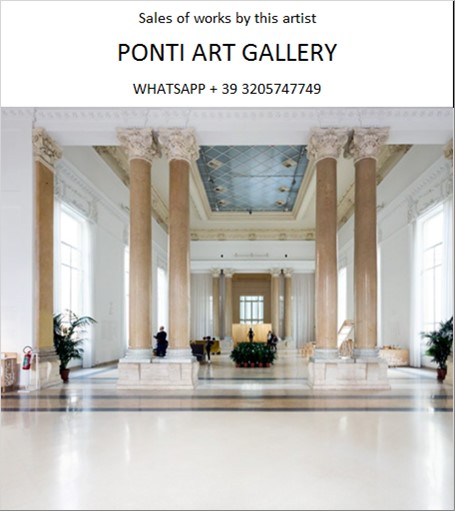Ponti Art Gallery is interested in buying and selling works
of art by this artist.

Wifredo Lam Biography
Wifredo Óscar de la Concepción Lam y Castilla, known as Wifredo Lam, was a Cuban artist whose work acted as a bridge between Western modernism and African and Caribbean symbolism. Born on December 8, 1902, in Sagua la Grande, Cuba, Lam was the eighth child of a Chinese immigrant father, Lam-Yam, who arrived in the Americas in the 1860s, and a Cuban mother of mixed African and Spanish ancestry, Ana Serafina Castilla. This rich cultural heritage would later become a cornerstone of his artistic identity.
Lam's early life in the lush, tropical environment of Sagua la Grande had a profound impact on his sensibilities as an artist. He was exposed to a blend of religious and cultural traditions, including Catholicism and the animist rites of African traditions, which would later permeate his work. At the age of 14, Lam enrolled at the Escuela de Bellas Artes in Havana, where he began to exhibit his work in annual salons, primarily focusing on still life and landscapes.
In 1916, Lam moved to Havana, where he initially studied law but soon shifted his focus to art, enrolling at Havana’s School of Fine Arts. His talent was recognized early on, and by 1923, after winning a grant from the municipality of Sagua la Grande, he traveled to Spain to further his education. There, he studied under Fernando Álvarez de Sotomayor, the director of the Museo del Prado and Salvador Dalí's former instructor. Lam's stay in Spain, which was intended to be brief before moving on to Paris, extended to 14 years, during which he was exposed to the works of Spanish masters and became involved in anti-Fascist political activities.
The Spanish Civil War marked a turning point in Lam's life. He fought for the Republican side and, after the loss of his first wife and son to tuberculosis, his art began to reflect themes of suffering and motherhood. In 1938, he left Spain for Paris, where he met and was influenced by Pablo Picasso, who introduced him to other members of the Parisian avant-garde. Picasso's encouragement led Lam to explore African art and tribal masks, which would become integral to his work.
Lam's time in Paris was cut short by the outbreak of World War II. He fled to Marseille and then to Martinique, where he was influenced by the Caribbean culture and reconnected with his Afro-Cuban roots. This period was crucial in the development of his signature style, which blended Modernist aesthetics with Afro-Cuban imagery.
In 1941, Lam returned to Cuba, where he developed his iconic style, combining elements of Cubism, Surrealism, and Afro-Cuban art. His most famous work, "The Jungle" (1943), is a testament to this synthesis, depicting hybrid figures in a dense tropical setting, reflecting the complex socio-cultural landscape of Cuba.
Throughout the 1940s and 1950s, Lam's work gained international recognition. He exhibited extensively, including solo shows at the Galerie Pierre in Paris and the Pierre Matisse Gallery in New York. His work was also included in major group exhibitions, such as the Venice Biennale. Lam's circle of friends and collaborators included leading figures of the European avant-garde, such as André Breton, Joan Miró, and Asger Jorn, as well as American artists like Arshile Gorky and Jackson Pollock.
In the latter part of his life, Lam continued to travel between Europe and the Americas, maintaining studios in Paris, Italy, and Cuba. He experimented with various media, including printmaking and ceramics, and his work continued to evolve, though it always retained its core elements of cross-cultural hybridization and spiritual symbolism.
Lam's legacy is vast, influencing not only the art world but also contributing to the cultural dialogue around identity, colonialism, and the global African diaspora. His work is held in numerous prestigious collections, including the Museum of Modern Art and the Guggenheim Museum in New York, and the Tate in London.
Wifredo Lam passed away on September 11, 1982, in Paris. He was cremated, and his ashes were spread on the soil of his homeland, Cuba, in accordance with his wishes. Today, Lam is celebrated as a pioneering figure in modern art, whose work transcends cultural boundaries and continues to inspire new generations of artists around the world.
Wifredo Lam Quotes and Sales
of Works
Ponti Art Gallery selects and deals with paintings by the
artist. Upon request, we provide free estimates and
evaluations, communicate prices, quotations, and current
market values.
If you are interested in BUYING or SELLING works by the
artist, contact us immediately.
If you wish to sell or receive an evaluation of the
works:
Send us a frontal photo of the painting, one of the back,
and one of the signature. Also, indicate the dimensions of
the work. Inform us about the purchase origin of the work
and any kind of available documentation (purchase
receipts, certificates of authenticity, publications). One
of our operators will respond to you on the same day. We
guarantee maximum confidentiality and extreme
professionalism.
If you wish to purchase works by the painter: Contact us
and let us know your request. We will inform you about the
available works. We also offer the possibility to
subscribe to our NEWSLETTER, through which you will be
informed at the beginning of each month about the latest
acquisitions of the art gallery.
You can send us pictures of the work:
